1. Overview
Pope Clement V, born Raymond Bertrand de Got around 1264, served as the head of the Catholic Church and ruler of the Papal States from June 5, 1305, until his death on April 20, 1314. His pontificate is primarily remembered for two significant and controversial actions: the suppression of the powerful Knights Templar and the relocation of the Papal See from Rome to Avignon, which marked the beginning of the Avignon Papacy. These decisions, heavily influenced by the political pressures of Philip IV of France, profoundly impacted the authority and independence of the papacy and reshaped the political landscape of medieval Europe. Clement V's reign is often viewed critically for its perceived subservience to the French crown and the resulting weakening of papal power.
2. Early Life and Career
Raymond Bertrand de Got's early life laid the foundation for his eventual rise within the ecclesiastical hierarchy, culminating in his election as Pope.
2.1. Birth and Family Background
Raymond Bertrand de Got was born around 1264 in Villandraut, a town located in the historic region of Aquitaine, which was then part of the Duchy of Aquitaine, a possession of the English crown. He was the son of Bérard, who held the title of Lord of Villandraut. His birthplace was within what is now France, but at the time, Aquitaine was under English suzerainty.
2.2. Education
Bertrand de Got pursued a comprehensive education, beginning with studies in the arts at Toulouse. He then specialized in law, undertaking advanced studies in both canon law (the law governing the Catholic Church) and civil law at the renowned universities of Orléans and Bologna. His legal expertise would prove influential in his later ecclesiastical and papal career.
2.3. Ecclesiastical Career
Bertrand de Got's career within the Church progressed steadily through various important roles. He first served as a canon and sacristan at the Cathedral of Saint-André in Bordeaux. Subsequently, he became the vicar-general to his elder brother, Bérard de Got, who was the Archbishop of Lyon. In 1294, his brother was elevated to Cardinal-Bishop of Albano and appointed a papal legate to France.
Bertrand himself was later appointed Bishop of St-Bertrand-de-Comminges, where he oversaw significant enlargement and embellishment of the cathedral church. He also served as a chaplain to Pope Boniface VIII, who, in 1297, appointed him Archbishop of Bordeaux. While holding this position, Bertrand de Got was technically a subject of the King of England due to Aquitaine's political status. However, from his early youth, he had cultivated a close personal friendship with Philip the Fair, a relationship that would profoundly influence his future pontificate.
3. Papal Election
The election of Bertrand de Got as Pope Clement V was a protracted and politically charged process, heavily influenced by the power struggles of the time, particularly the ambitions of the French monarchy.
3.1. The Conclave and Interregnum
Following the death of Pope Benedict XI in July 1304, the papal conclave convened in Perugia to elect his successor. However, the process was severely prolonged by deep divisions between the French and Italian cardinals, who were almost equally balanced in their numbers and influence. This resulted in a lengthy interregnum of nearly a year, during which the Holy See remained vacant, reflecting the intense political deadlock within the Church.
3.2. Influence of Philip IV
King Philip IV of France exerted significant political pressure throughout the interregnum and on the eventual election. His desire to assert royal authority over the Church, especially after his bitter conflicts with Pope Boniface VIII, made him a formidable force. Contemporary chroniclers, such as Giovanni Villani, reported rumors that Bertrand de Got had entered into a formal agreement with King Philip IV at Saint-Jean-d'Angély in Saintonge even before his elevation to the papacy. While the exact details of such an agreement remain speculative, it is widely believed that the conclave of cardinals laid down certain conditions for the future pope, likely influenced by the prevailing political climate and Philip IV's strong stance.
3.3. Election as Clement V
In June 1305, Bertrand de Got, who was neither an Italian nor a cardinal at the time, was elected Pope. His election was perhaps seen as a gesture towards neutrality, a compromise between the feuding French and Italian factions. He formally accepted the election and took the papal name Clement V. Although he was urged to travel to Italy for his coronation, Clement V, influenced by Philip IV, chose Lyon in France as the site for the ceremony, rather than Vienne as he had initially considered.
On November 14, 1305, Clement V's papal coronation was celebrated with great magnificence in Lyon, with King Philip IV himself in attendance. This event underscored the close ties between the new Pope and the French monarch. One of Clement V's immediate actions as Pope was the creation of nine new cardinals, all of whom were French, further solidifying French influence within the College of Cardinals. During the coronation celebrations, a tragic accident occurred: John II, Duke of Brittany, who was leading the Pope's horse through the crowd, was crushed when a wall, overburdened by spectators, collapsed. He died four days later from his injuries.
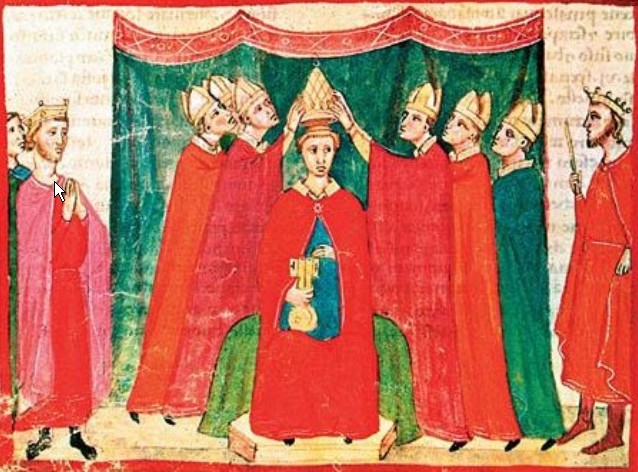
4. Pontificate
Clement V's pontificate was marked by several pivotal events and policies that significantly altered the course of Church history, most notably the relocation of the Papal See and the suppression of the Knights Templar.
4.1. Avignon Papacy
In March 1309, Clement V made the momentous decision to relocate the entire papal court from Poitiers to the Comtat Venaissin, a papal territory surrounding the city of Avignon. The court was initially established in Carpentras, the capital of the territory, before settling permanently in Avignon. This move was justified by French apologists at the time on grounds of security, citing the instability and danger in Rome, where conflicts between the Colonna and Orsini factions had reached a low point, and the Basilica di San Giovanni in Laterano had been destroyed by fire.
However, this decision proved to be the precursor to the nearly 70-year period known as the Avignon Papacy (1309-1377), famously dubbed the "Babylonian captivity" by the Italian poet Petrarch. This relocation signaled a significant shift in papal authority, marking a period where the papacy was perceived to be under the strong influence, if not outright control, of the French monarchy, leading to a decline in its perceived independence and universal authority.
4.2. Suppression of the Knights Templar
The suppression of the Knights Templar stands as one of the most controversial and impactful events of Clement V's pontificate, largely driven by the relentless pressure from Philip IV. Early in 1306, Clement V made significant concessions to Philip IV, effectively explaining away the features of Pope Boniface VIII's papal bull Clericis Laicos (which prohibited secular rulers from taxing clergy without papal consent) and essentially withdrawing Unam Sanctam (which asserted papal supremacy over secular rulers). This represented a radical shift in papal policy, reversing the strong stance of his predecessor and accommodating Philip's political agenda.
On Friday, October 13, 1307, hundreds of Knights Templar were arrested across France. This action, orchestrated by Philip IV's efficient royal bureaucracy, was primarily motivated by financial gain and a desire to enhance the prestige and power of the French crown. From the very day of Clement V's coronation, Philip IV had leveled accusations against the Templars, including usury, credit inflation, fraud, heresy, sodomy, immorality, and abuses. The Pope's initial scruples about these charges were increasingly overridden by a growing concern that the burgeoning French state might act independently against the Church if he did not comply.
Philip IV's lawyers also pressed to reopen charges of heresy against the deceased Boniface VIII, which had circulated during the pamphlet war surrounding Unam Sanctam. Clement V was compelled to yield to pressure for this extraordinary trial, which began on February 2, 1309, in Avignon and dragged on for two years. Although Clement V expressed his personal conviction of Boniface VIII's innocence, he felt obliged to satisfy the king. Ultimately, in February 1311, Philip IV agreed to abandon the process, leaving the matter to the future Council of Vienne. In return, Clement V absolved all participants in the abduction of Boniface at Anagni.
In line with the king's wishes, Clement V summoned the Council of Vienne in 1311. Despite the council's refusal to convict the Templars of heresy, the Pope decided to abolish the order anyway. He justified this decision by stating that the Templars were in bad repute and had outlived their usefulness as papal bankers and protectors of pilgrims in the East. The papal bull Vox in coelo (1312) formally dissolved the order. Clement V decreed that the Templars' vast assets in France should be transferred to the Knights Hospitaller. However, Philip IV largely confiscated these assets for the French crown, openly using them until his death, thereby undermining the papal decree. The question of the Templars' guilt or innocence remains one of history's more complex problems, partly due to the hysterical atmosphere of the time and the subsequent embrace by conspiracy theorists. The torture of Templar leaders, including Grand Master Jacques de Molay, led to forced confessions. De Molay and other high-ranking officials were executed by fire in 1314. Legend states that de Molay cursed both Philip IV and Clement V from the pyre; coincidentally, both men died within the same year.
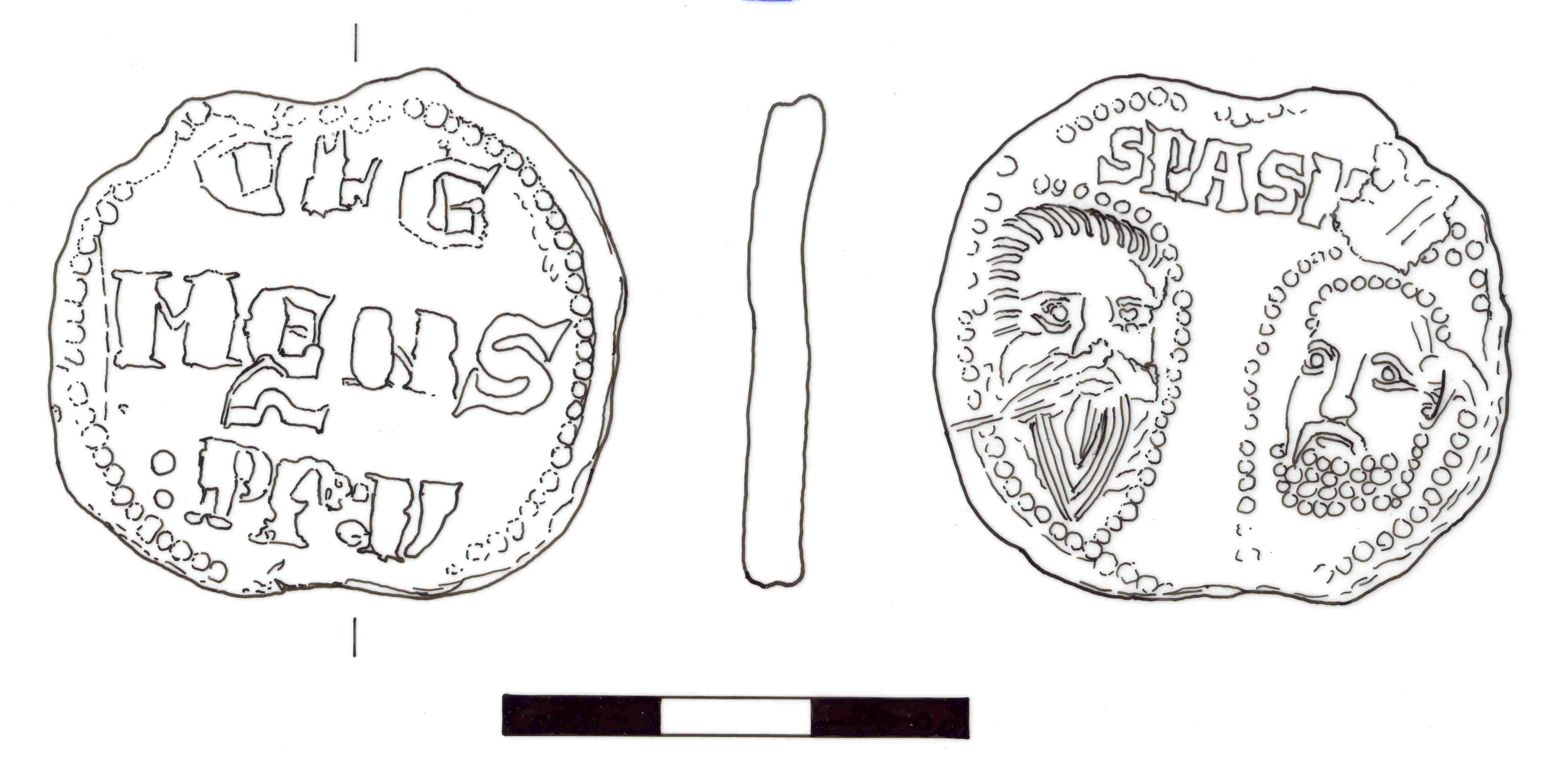
4.3. Council of Vienne
The Council of Vienne, the fifteenth ecumenical council of the Catholic Church, was convened by Pope Clement V in 1311 and concluded in 1312. Its primary objectives included addressing the fate of the Knights Templar, resolving the accusations against the late Pope Boniface VIII, and undertaking church reform. While the council did not find the Templars guilty of heresy, Clement V, under intense pressure from Philip IV, proceeded with the dissolution of the order through the bull Vox in coelo.
Beyond the Templar issue, the council also condemned certain heretical movements. It issued doctrinal and moral constitutions, notably condemning the erroneous views of Peter Olivi regarding the soul and the heresies espoused by Lambert le Bègue and the Beguines, who advocated a doctrine of earthly perfection and impeccability. Furthermore, the council promulgated several decrees aimed at reforming the Church, particularly concerning the life and conduct of the clergy.
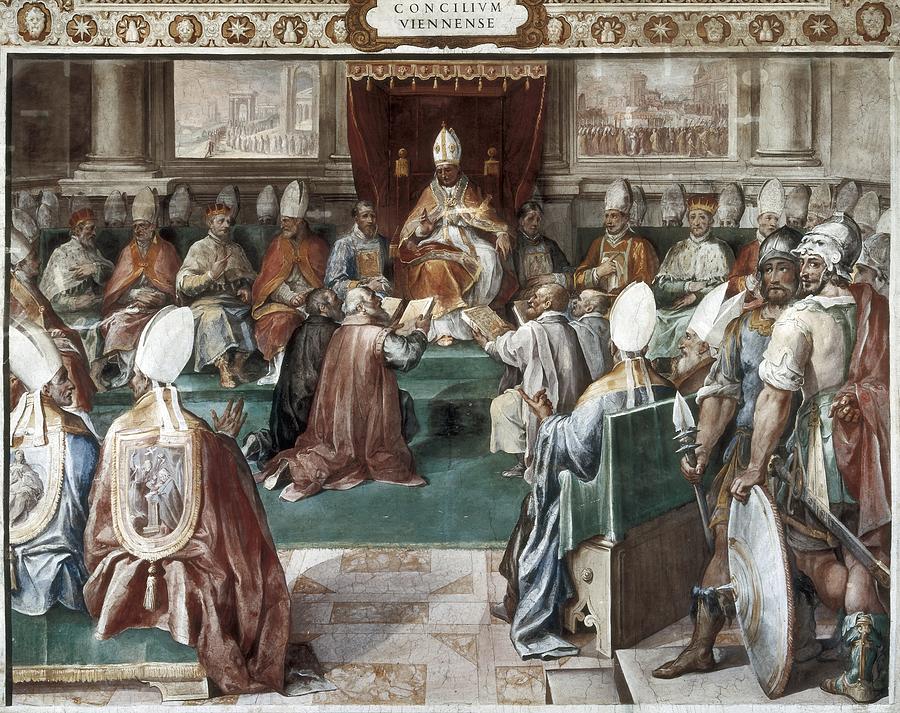
4.4. Relations with Philip IV of France
The relationship between Clement V and King Philip IV of France was exceptionally close and heavily influenced the entire pontificate. Philip IV, known as "the Fair," exerted unprecedented pressure on the papacy, which Clement V largely accommodated. This influence began even before Clement's election, with rumors of a pre-election agreement and Philip's insistence on the coronation taking place in Lyon.
Throughout his reign, Clement V made significant concessions to the French crown, including the withdrawal of key papal bulls from his predecessor, Boniface VIII, that had asserted papal supremacy over secular rulers. His appointment of numerous French cardinals further entrenched French influence within the College of Cardinals. The most prominent example of this subservience was Clement V's handling of the Knights Templar, where despite the Council of Vienne's findings, he yielded to Philip IV's demands for the order's suppression, allowing the French king to seize their substantial assets. This close relationship and the resulting papal decisions led to widespread criticism that Clement V had compromised the independence and authority of the papacy.
4.5. Crusades and Relations with the Mongols
Clement V maintained an active interest in crusading efforts and engaged in diplomatic overtures towards the Mongol Empire, aiming to form alliances against the Muslim powers in the Middle East. He dispatched the Franciscan missionary John of Montecorvino to Khanbaliq (modern-day Beijing), the capital of the Yuan Dynasty, to preach Christianity in China.
Intermittently, Clement V communicated with the Mongol Ilkhanate rulers, exploring the possibility of a Franco-Mongol alliance against the Mamluk Sultanate in the Holy Land. In April 1305, the Ilkhan ruler Öljaitü sent an embassy led by Buscarello de Ghizolfi to Clement V, Philip IV of France, and Edward I of England. Another Mongol embassy, led by Tommaso Ugi di Siena, reached European monarchs in 1307. However, despite these diplomatic exchanges and a further embassy from Öljaitü in 1313 to Edward II of England, no coordinated military action materialized, and hopes for a lasting alliance eventually faded within a few years.
In 1308, Clement V ordered the preaching of a crusade to be launched against the Mamluk Sultanate in the Holy Land, scheduled for the spring of 1309. This call resulted in the unexpected appearance of the "Crusade of the Poor" before Avignon in July 1309. Clement V granted these poor crusaders an indulgence but refused to allow them to participate in the professional expedition, which was to be led by the Knights Hospitaller. That professional expedition set off in early 1310, but instead of sailing for the Holy Land, the Hospitallers diverted their efforts and successfully conquered the city of Rhodes from the Byzantines. On April 4, 1312, a new crusade was formally promulgated by Pope Clement V at the Council of Vienne. In the same year, Philip IV of France "took the cross," making a solemn vow to go on a Crusade in the Levant.
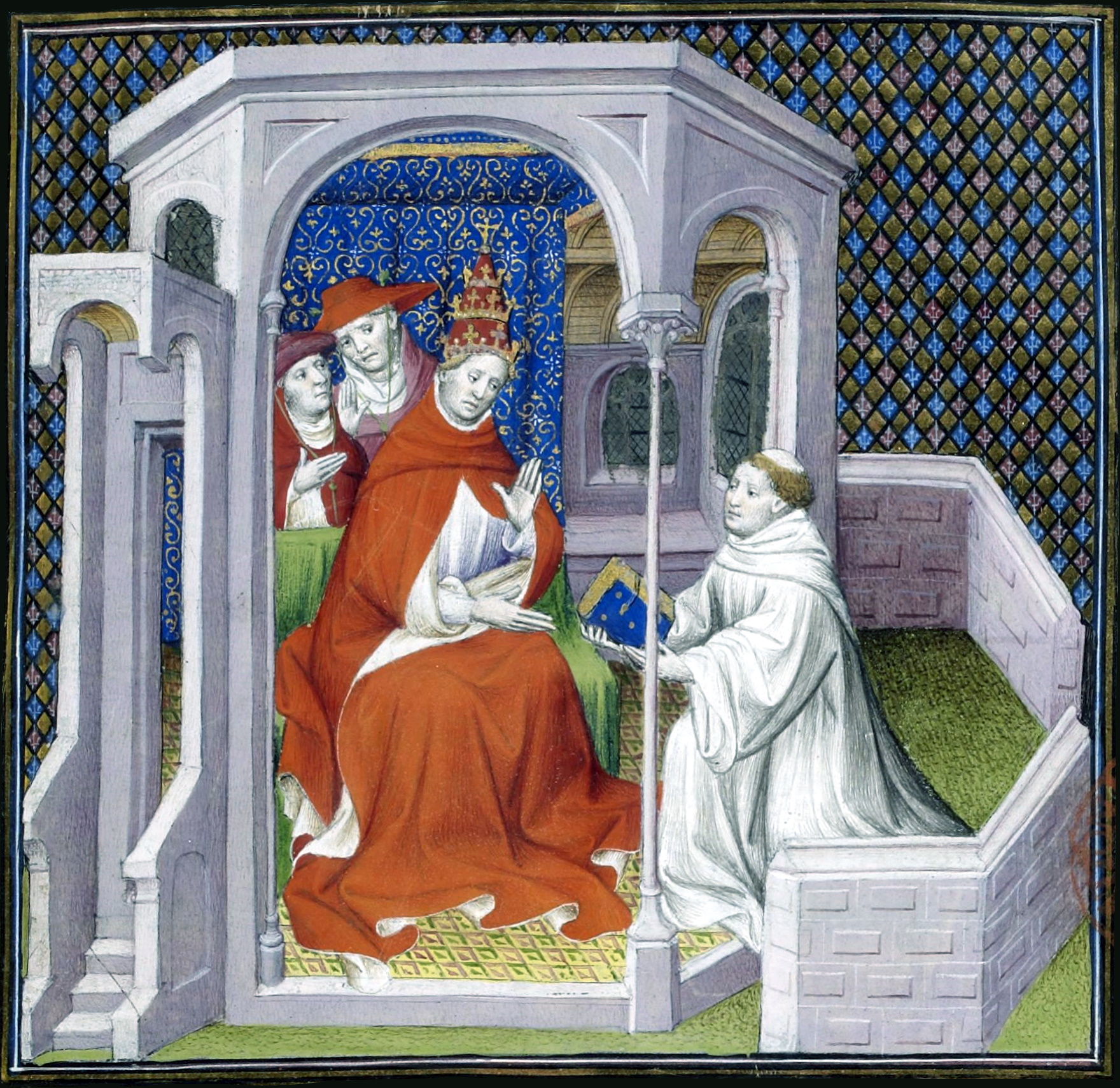
4.6. Relations with Rome and Italy
Clement V's pontificate was a period of considerable instability for Italy and the Papal States. With the Papal See relocated to Avignon, the administration of the Papal States was entrusted to a team of three cardinals. However, Rome itself remained ungovernable, serving as a battleground for the feuding noble factions of the Colonna and Orsini.
In 1310, Henry VII, Holy Roman Emperor, entered Italy, seeking to reassert imperial authority. He established the Visconti family as imperial vicars in Milan. In 1312, Henry VII was crowned Holy Roman Emperor by Clement V's legates in Rome, a significant event given the Pope's absence. However, Henry's ambitions led to conflict with Robert of Naples, whom Clement V supported, even threatening the emperor with excommunication and interdict. This crisis was averted by Henry VII's unexpected death near Siena in 1313.
Another notable conflict during Clement V's reign involved Ferrara. When Ferrara was absorbed into the Papal States, excluding the local Este family, papal armies clashed with the Republic of Venice and its populace. When excommunication and interdict failed to achieve the desired effect, Clement V took the extreme measure of preaching a crusade against the Venetians in May 1309. He controversially declared that Venetians captured abroad might be sold into slavery, similar to non-Christians.
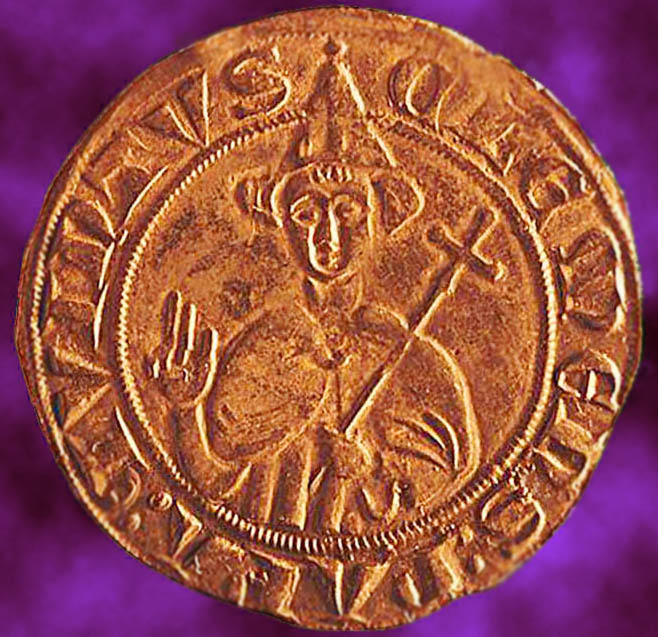
4.7. Other Policies and Activities
Beyond the major events of the Avignon Papacy and the Templar suppression, Clement V's pontificate saw other significant actions. He initiated a violent repression of the Dulcinians in Lombardy, a movement he considered a heresy. In 1313, he promulgated the Clementine Constitutions, a collection of canon law that codified various papal decrees and council decisions from his reign. This collection was later reissued by Pope John XXII in 1317.
Clement V also played a role in the development of higher education, establishing universities in Perugia, Oxford, and Orléans. However, his generous grants and financial support to French kings, his relatives, and various charitable organizations in France led to a significant depletion of the Holy See's treasury. At the time of his death, the papal coffers had reportedly dwindled from approximately 1.04 million gold coins to about 70,000 gold coins.
5. Death and Burial
Pope Clement V died on April 20, 1314. According to historical accounts, his death was dramatic. While his body was lying in state, a severe thunderstorm erupted during the night. Lightning struck the church where his body lay, setting it ablaze. The fire was so intense that by the time it was extinguished, the Pope's body had been almost entirely consumed. This unusual event fueled speculation and was often linked to the curse allegedly pronounced by Jacques de Molay, the last Grand Master of the Knights Templar, who was executed by fire in the same year. Clement V's will stipulated that he be buried at the collegiate church in Uzeste, a location close to his birthplace in Villandraut.
6. Assessment and Legacy
Clement V's pontificate is a complex and often criticized period in the history of the papacy, leaving a lasting impact on the Church and the political landscape of Europe.
6.1. Historical Evaluation
Historically, Clement V's pontificate is largely viewed as a turning point that initiated a period of decline in papal authority. His election, heavily influenced by Philip IV, and his subsequent decisions, particularly the relocation to Avignon and the handling of the Knights Templar, are seen as significant concessions that undermined the papacy's independence and prestige. While he did pursue some traditional papal objectives, such as crusades and missionary efforts, these were often overshadowed by his perceived subservience to the French crown.
6.2. Criticism and Controversies
Clement V faced considerable criticism both during and after his reign. The most prominent criticism centers on his perceived subservience to the French crown, particularly King Philip IV. His actions, such as explaining away Boniface VIII's bulls and consenting to the suppression of the Knights Templar without a clear conviction of heresy by the Council of Vienne, were seen as capitulations to secular power. Critics argue that his handling of the Templar affair was driven more by political expediency and Philip IV's financial and political ambitions than by genuine ecclesiastical justice. The move to Avignon, though initially justified by the instability in Rome, ultimately led to the "Babylonian Captivity" and was widely seen as weakening papal authority by placing it under French influence, leading to a loss of universal respect for the papacy.
6.3. Impact on the Papacy and European Politics
The long-term effects of Clement V's decisions were profound. The establishment of the Avignon Papacy fundamentally altered the institution of the papacy, transforming it from a universally recognized spiritual and temporal power based in Rome to one perceived as a tool of French royal policy. This shift led to a decline in papal prestige and contributed to the growing anti-papal sentiment in other European kingdoms, particularly the Holy Roman Empire and England. The subsequent Western Schism, which saw rival popes in Rome and Avignon, can be seen as a direct consequence of the Avignon Papacy's divisive legacy. Clement V's actions thus played a crucial role in the transition of medieval European politics, contributing to the rise of national monarchies and the eventual decline of the universalist claims of both the papacy and the Holy Roman Empire.
7. In Popular Culture
Pope Clement V has been portrayed in various forms of popular culture. In the second season of the historical drama television series Knightfall, which focuses on the final days of the Knights Templar, Pope Clement V is portrayed by actor Stephen Fewell.